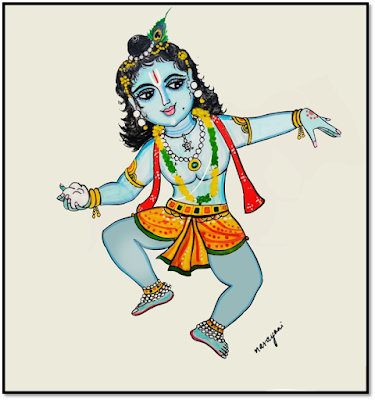HOLI MAHOTSAV
The Sweet PhAlguna month
The gOpikas were blessed to be born in the cowherd clan due to the many good karmas done by them in the previous birth. Their fathers belonged to the rank of upanandas, nine of them who were wealthy, handsome, having many children, well learned, kind and charitable.
“Oh, rambhOru! ChandravadanA! madhumAninee! Listen to our sweet message! Hari, the precious gem of Vraja, has arrived in our garden city on a Holi celebration trip.
The gOpikA continued,
Oh, rAdhikA! The handsome young lad is full of cheer. The sound from his jingling anklets that adorn His lotus feet, is attracting everyone towards Him. His yellow garment peetAmbara adds to His resplendence.
Radha was the most beloved gOpi of krishNa. Our hero and heroine were assisted by many gOpis. Out of them, the aShTa sakhis were their closest friends. They were eight group leaders namely LalitA, ChampakalatA, VishAkhA, ChitrA, TungavidyA, IndulEkhA, RangadEvi and SudEvi. They were experts in leadership, counselling, cooking, singing, instrumental music, weaving, decoration, hair-do, garland making, jewelery making, dance, drama, literature, art, gemology, logical reasoning and prediction.
"Oh, rAdhA rAni, Your charming ShyAmala Hari wears beautiful arm bands, a necklace called hAram and a garland called vanamAlA. The reflection of His peetAmbara and the ornaments on His cloud colored body looks like a rainbow across the sky laden with rain clouds.
The gOpis knew well, the greatness of rAdhA's birth and her special connect with Krishna. VrishabhAnu and Keertida dEvi, a childless couple, found a beautiful girl baby floating on a lotus along the yamunA river. As she fulfilled their wishes, they named their cute doll, 'rAdhA' and took her home happily. But to their dismay, rAdhA did not open her eyes at all. During one of the vraj festivals, little Krishna chanced to glance upon little rAdha who was confined in her cot. Immediately, rAdhA opened her lotus eyes for the first time and saw krishNa. All the vrajvAsis were thrilled. Since then, she was called by the pet name KishOri, having regained her beauty due to Nanda Kishore's glance.
The gOpikA exclaims with glee,
Oh, madhu mAninee! Hari's dark, curly tresses cascade down His shoulders and caress His rolling eyes that gleam like blue lotus. His sleek crown, mukuTam shines like the tender baby sun. His fish-shaped earrings, the makara kunDalas dazzle like electricity.
So, the beautiful, talented ashTasakhis of rAdhA also called parama prEshTa sakhis were the most exalted as they carefully assisted Radha and krishNa in their pastimes. No one could excel them in their whole-hearted love for the Divine Couple. In the loving quarrel between Sri Hari and rAdhA rAni, they took the side of rAdhA rAni but sometimes pacified them too.
Oh, rAdhE! Smeared with saffron essence, KrishNa stands with the spray pump - pichkAri filled with colorful water and colors in hand. Brimming with fondness like the flower blossoms, He is eagerly waiting to play HOLI with you. Enough of it! Give up your ego now! Shed your anger! Under the pretext of the HOLI festival of PhAlguna month, go and meet Him. You will not get this wonderful opportunity again.
Radha agreed and her sakhis gathered all the HOLI parapheranalia like water, pichkAri, kumkum, pouches of colors called gulAl, saffron paste, sandal paste, and honey of flowers and left to see KrishNa.
Effulgent KrishNa was waiting with a sweet smile. They sprayed perfumed waters on Him. The colors from their hands filled the air covering KrishNa. Acknowledging their pure devotion, KrishNa manifested into many and played rang raas with them. rAdhA gave up her petty quarrel with KrishNa and finally immersed herself in the divine joy. Delighted with the holy panorama, the Gods together showered flowers of blessings on them.
May we also join the happiness and celebrate the sublime love of rAdhA krishNa on the auspicious occasion of HOLI MAHOTSAV.
Thanks for enjoying!
ADIYEN
Drawings and Story Line - Smt. Malathi Balaji
Excerpts drawn from Srimad Garga SamhitA and Sri RAdhA KrishNa GanOddEsha DeepikA.
With humble salutations to the lineage of our Gurus of SanAtana Dharma,
VandE Guru ParamparAm!
RAdhE KrishNa!
1 : मृदुल भाषिणी राधा ! राधा !! 2 : सौंदर्य राषिणी राधा ! राधा !! 3 : परम् पुनीता राधा ! राधा !!
4 : नित्य नवनीता राधा ! राधा !! 5 : रास विलासिनी राधा ! राधा !! 6 : दिव्य सुवासिनी राधा ! राधा !!
7 : नवल किशोरी राधा ! राधा !! 8 : अति ही भोरी राधा ! राधा !! 9 : कंचनवर्णी राधा ! राधा !!
10 : नित्य सुखकरणी राधा ! राधा !! 11 : सुभग भामिनी राधा ! राधा !! 12 : जगत स्वामिनी राधा ! राधा !!
13 : कृष्ण आनन्दिनी राधा ! राधा !! 14 : आनंद कन्दिनी राधा ! राधा !! 15 : प्रेम मूर्ति राधा ! राधा !!
16 : रस आपूर्ति राधा ! राधा !! 17 : नवल ब्रजेश्वरी राधा ! राधा !! 18: नित्य रासेश्वरी राधा ! राधा !!
19 : कोमल अंगिनी राधा ! राधा !! 20 : कृष्ण संगिनी राधा ! राधा !! 21 : कृपा वर्षिणी राधा ! राधा !!
22: परम् हर्षिणी राधा ! राधा !! 23 : सिंधु स्वरूपा राधा ! राधा !! 24 : परम् अनूपा राधा ! राधा !!
25 : परम् हितकारी राधा ! राधा !! 26 : कृष्ण सुखकारी राधा ! राधा !! 27 : निकुंज स्वामिनी राधा ! राधा
28 : नवल भामिनी राधा ! राधा !! 29 : रास रासेश्वरी राधा ! राधा !! 30 : स्वयं परमेश्वरी राधा ! राधा
31 : सकल गुणीता राधा ! राधा !! 32: रसिकिनी पुनीता राधा ! राधा !!
कर जोरि वन्दन करूं मैं
नित नित करूं प्रणाम
रसना से गाती रहूं
श्री राधा राधा नाम !!

~2.jpg)






